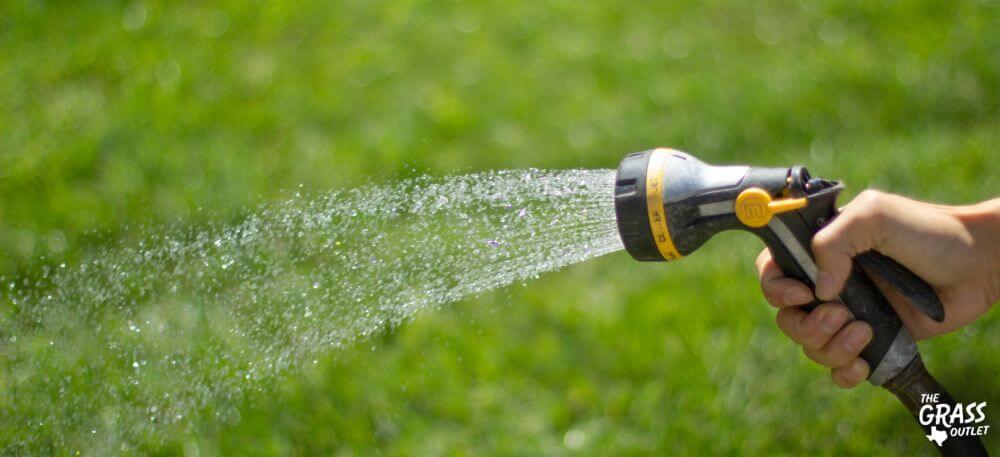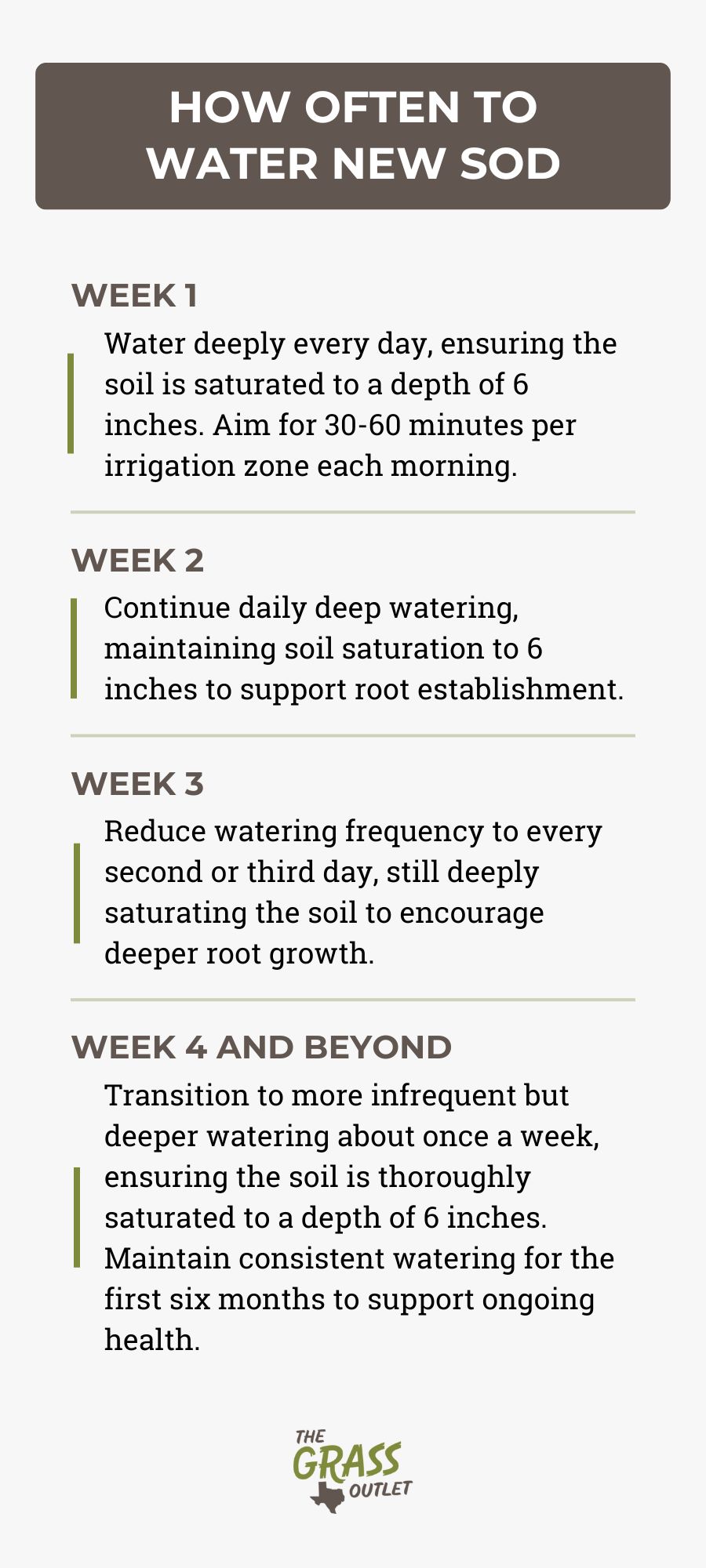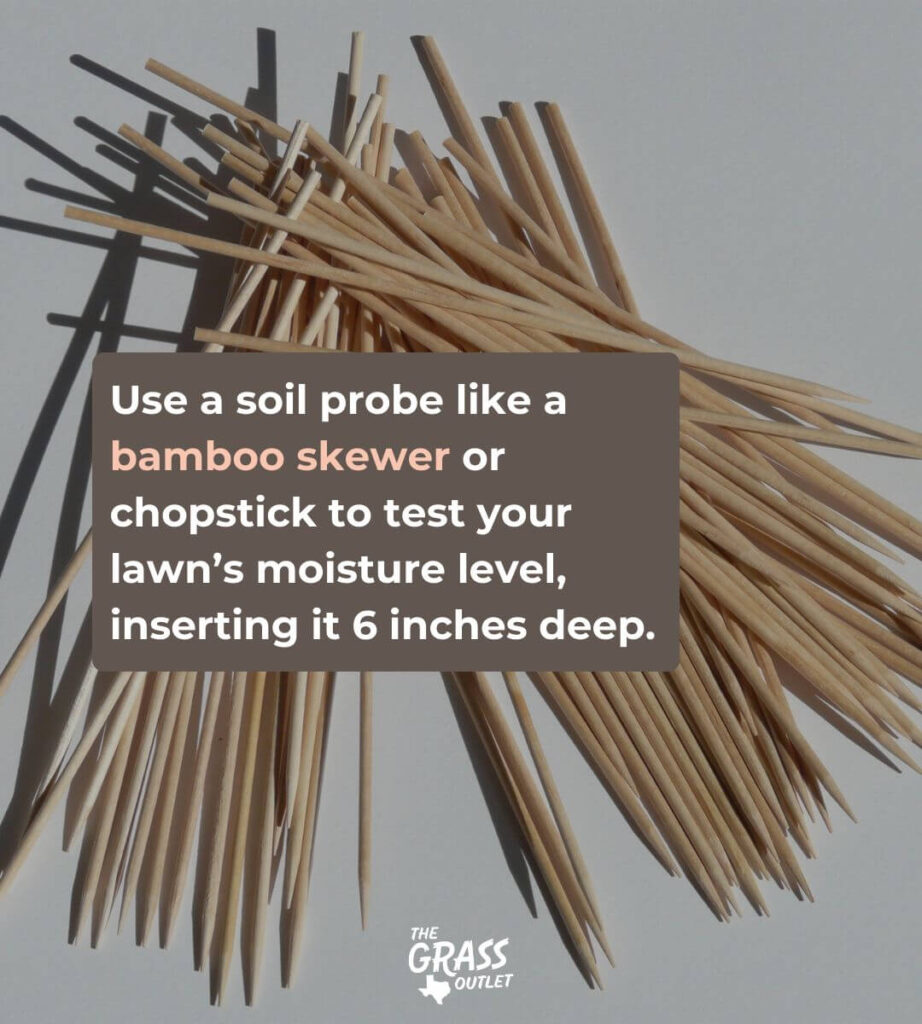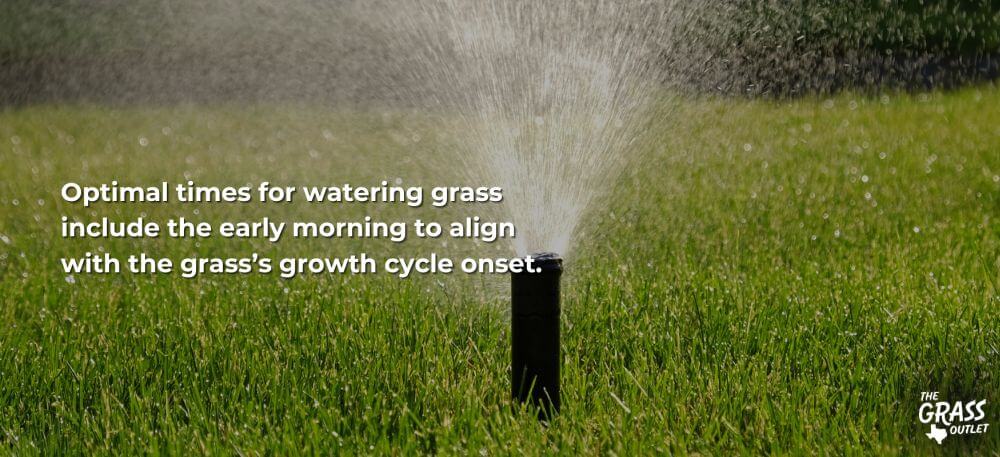How Often to Water New Sod
If you choose sod to establish your new lawn, you should take good care of it. Adequate watering is essential in ensuring your lawn’s health and beauty.
Understanding when, how, and what the appropriate amount of water is crucial. In this blog post, we bring you the best practices and guidelines for watering your newly laid sod, whether it’s the resilient Zoysia, the drought-tolerant Bermuda grass, or the lush St. Augustine sod.

Initial Watering After Sod Installation
Proper watering immediately after installing new sod is mandatory for its successful establishment in the soil. Once the sod company delivers fresh grass to your site, it must be thoroughly watered within 30-45 minutes of laying it in your garden, ensuring sufficient moisture penetrates the soil beneath the turf. It is recommended that the soil under the sod remains moist to a depth of 6 inches during most months; however, 2-3 inches is sufficient when planting during winter dormancy.
Proper watering prevents the grass from drying out before it can develop roots. However, be cautious not to overwater it, as excessive moisture can lead to root rot.
Watering Sod in the 1st Two Weeks
In the initial two weeks following installation, your fresh sod needs frequent deep watering. At the end of this period, you should be able to see the development of roots extending into the soil.
Water your new grass deeply every day, typically running your irrigation system for anywhere between 30-60 minutes per zone, to ensure the soil is saturated 6 inches deep each morning. It is of absolute essence that during each watering in the first week, the roots and soil receive adequate moisture, supporting the establishment of the sod to take roots into the soil.
Watering Sod in the 3rd Week – Adjustments in Watering Frequency
Entering the third week, reduce the frequency of watering sessions to every second or third day, continuing with the runtime necessary to saturate the soil deeply. You still want your soil wet 6 inches deep to encourage the roots to follow the water deeply into the soil.
To protect the sod from potential damage, keep an eye out for any dry patches that may require extra moisture. On the other hand, if you are in a region with frequent rainfall, be sure that weather conditions are aligned with your watering schedule to avoid overwatering.
To establish and maintain a healthy law, persist in overseeing the soil, ensuring it remains saturated without becoming excessively waterlogged or dried out.

Watering Sod in the 4th Week – Deep Watering and Root Establishment
Upon reaching the fourth week, your recently established sod should have securely taken root and is now ready for more infrequent yet deeper watering.
As the roots continue to delve deeper into the soil, you’ll find that you can extend the duration between watering sessions. During this phase, water your lawn about once a week or when it needs it, ensuring the soil is thoroughly saturated to a depth of 6 inches. This practice fosters the development of deeper roots, enhancing the lawn’s ability to withstand drought and improve its resilience.
However, although the roots are established, consistent watering remains crucial during the initial six months to support the lawn’s ongoing health. For more information on watering your lawn, check out our irrigation page.
Monitoring Soil Moisture
Soil moisture refers to the amount of water present in the soil. As it influences plant growth, soil temperature, and nutrients, it is of grave importance for sod health and root development. To maintain optimal soil moisture levels, you need to avoid and prevent both over and under-watering.

After the initial period of one month, your freshly laid sod should be well-established when installed during its growing season, allowing for a transition to a regular watering schedule. Typically, this involves watering your lawn every 7-14 days, depending on your local climate, variety planted, and soil composition. While consistent watering is essential for cultivating deep roots, excessive water can harm your lawn’s health. When watering the sod, ensure that the top six inches of soil is well saturated each time you irrigate.
Use a soil probe like a bamboo skewer or chopstick to test your lawn’s moisture level, inserting it 6-inches deep. If it wooden implement has about a 6-inch water line when removed 60 seaconds later, it indicates sufficient moisture; if not, it’s time to increase your water.
Special Considerations
Remember to adapt your watering practices considering your lawn’s condition, position, the 6 S’s – sprinkler head type, season, species, sunlight condtions, slope, and soil composition – and the varying weather conditions.
Take precautions to prevent the fresh sod from excessively drying out in high summer temperatures, leading to wilting.
Furthermore, ensure you water all lawn areas, focusing on often overlooked places like edges or corners. To optimize the watering’s effectiveness, you should pay special attention to challenging spots such as slopes and beneath trees. Understanding the water needs of the specific trees and the grass is essential for areas near trees. Despite trees having deep “anchor” roots, they draw moisture and nutrients from the top six inches of soil—similar to the grass in the same vicinity.
Long-Term Watering Practices
As we can see, the quantity of water and how it’s applied directly influences the overall health of your lawn. The typical water requirement for most lawns is around one inch per week, but this may vary among different turf species and even among cultivars within the same species. Additionally, seasonal changes and soil types contribute to variations in water needs.

Conclusion
Proper hydration is essential for the grass, ensuring it stays nourished and hydrated to grow and spread throughout the lawn. An adequate watering schedule is even more important for laying and establishing new sod.
Inadequate water supply will hinder the flourishing of the sod, resulting in a brown lawn far from your ideal turf. But at the same time, note that excess water can be just as detrimental to a lawn as insufficient water.
The key is to find the right measure. But usually, it is more complicated. For a professional approach and support in creating an adequate schedule of watering a new sod, contact The Grass Outlet. Our experts will provide you with appropriate information and guidelines to establish and maintain a healthy and attractive lawn.


